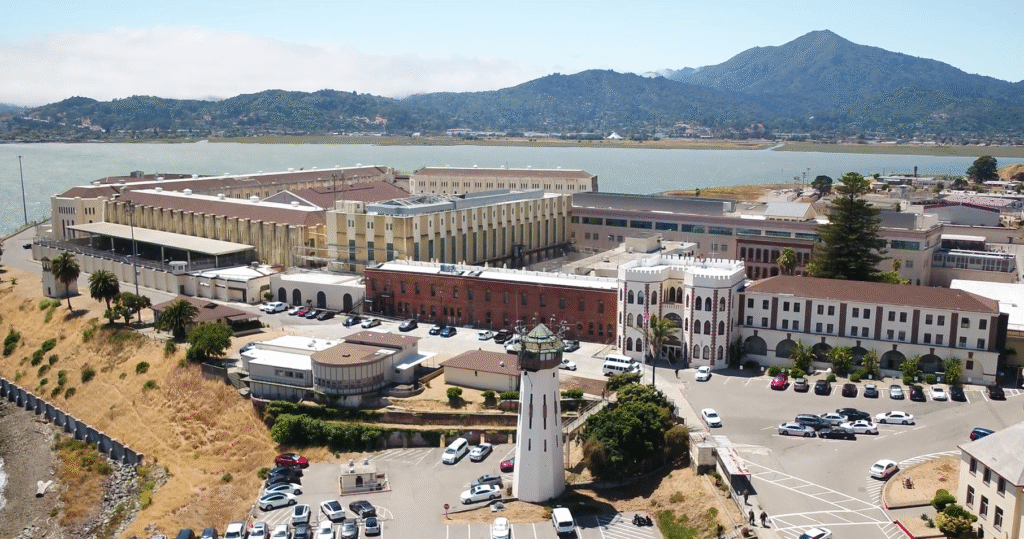California Governor Newsom is moving less-desirable inmates out of San Quentin Rehabilitation Center to make the California Model of prison management appear successful.
Anyone working for the California Department of Corrections and Rehabilitation (CDCR) is fully aware the “California Model” of prison management is a failure. The California Model is based on making inmates happy while in prison. What the California Model ended up doing was making prisons less safe and increasing the number of attacks on correctional officers.
Gov. Newsom is the political name behind the California Model, and he is determined to make this failed model appear to be a success. Although all prisons were expected to implement the California Model, much of focus will now be on one prison which was recently renamed to the San Quentin Rehabilitation Center. Newsome has already spent $239 million on this prison to give the inmates a coffee shop, movie theater, and shopping center. Come hell or high water, Newsom will show the California Model will be successful, even at the cost of staff safety and taxpayer money.
To ensure success at San Quentin, Newsom is moving inmates who might be a risk to California Model success. Even inmates who have never received a write-up (RVR) are being moved out of San Quentin if they don’t appear to be able to meet the ability to prove program success. Most of these are inmates with longer sentences.
On April 30, Warden, Chance Andes, sent out an email to San Quentin’s inmates over their Viapath tablets.
“This memorandum is being generated to formally canvas for IPs interested in voluntarily transferring to an alternate institution,” the memo reads. “A signup sheet will be located in your assigned unit with the desk officer.”
[“IP” is the new California Model name for inmate, it stands for “incarcerated person”.]
Before Warden Andes requested volunteers to transfer from San Quentin, another strategy was attempted. Inmates were allegedly wrongly being targeted for adverse transfers.
Adverse transfers are normally reserved for those considered to be “program failures” with two or more serious rule violations within a six-month period, according to state law. Getting an adverse transfer can hinder earning early release credits, maintaining access to jobs and programs at the prison, and can hinder people from being found suitable at a parole hearing.
Inmate James Bryant is one of those allegedly targeted. He received a classification committee chrono, a document that goes into an inmates’ file, that read:
“You have been identified as an IP who has demonstrated an unwillingness to comply with expectations that align with the values of SQRC and the California model. As such you will be transferred to an alternate institution in hopes to continue your rehabilitative efforts.”
Another inmate, who lives in a privileged unit with single cells and a canine companion program, received a similar classification notice. This inmate wishes to remain anonymous out of fear of reprisal. His chrono, which refers to rule violation reports, or RVRs, read:
“After an extensive file review and case conferences with institutional staff, it has been determined subject’s behavior is not favorable to the mission of SQRC. Although subject has not received any RVRs for his behavior, staff have consistently attempted to use dynamic security techniques in order to change his behavior with no avail. As such subject will be transferred to an alternate institution in hopes to continue his rehabilitative efforts in an environment that best suits his needs.”
The inmates facing transfers expressed serious concern about the punitive language being used against them and placed in their central file records without warning. Neither wants to transfer or be removed from their current programs.

California penal code requires CDCR to “minimize transfers from institutions, facilities, or sections of the institutions or facilities from disrupting an incarcerated person’s programming.”
The penal code specifically advises CDCR not to transfer inmates unless it is for adverse reasons. Any transfer for non-adverse reasons requires CDCR to prioritize people for similar programming opportunities at the next institution.
But most California prisons don’t have as many available programs as San Quentin. An inmate with a job or school assignment at San Quentin may be unemployed and unable to find schooling or other programs for years at their next institution.
In typical Gov. Newsom fashion, he will ignore the penal code and security of the CDCR prisons to ensure his California Model looks to be effective. Newsom has put so much political weight behind the victim-offending California Model, he is willing to spend millions in tax dollars to present the image that it is working.

The Toughest Beat has written several articles in the past detailing how horrible the California Model is for staff and inmates. Making inmates happy is not a safe or effective way to meet rehabilitation goals. Moreover, the California Model is detrimental to crime victims. This author does not expect Newsom to have a change of heart and meet with criminology experts on what can be done, but this author hopes the staff do the best they can to be safe.
Just so you do not get confused: The California Model of prison management is not based on any other model to include the Norway Model. CDCR and Gov. Newsom has spread many lies about the California Model in the past few years as an attempt to re-define the failed model. The California Model is only been designed to make inmates happy, to make the prison experience for inmates as fun as possible.

Governor newsom the “newscum” of California has managed to wreck the beautiful state of California. He has managed to put us in deep debt spending the TAX PAYERS money into his pipe dream.
In my opinion, it appears that the above noted governor is out of control as well as way out of line with his dilutions of greatness. He appears to me to be placing the safety and security of Correctional Officers as well as the institutional practices in high risk.